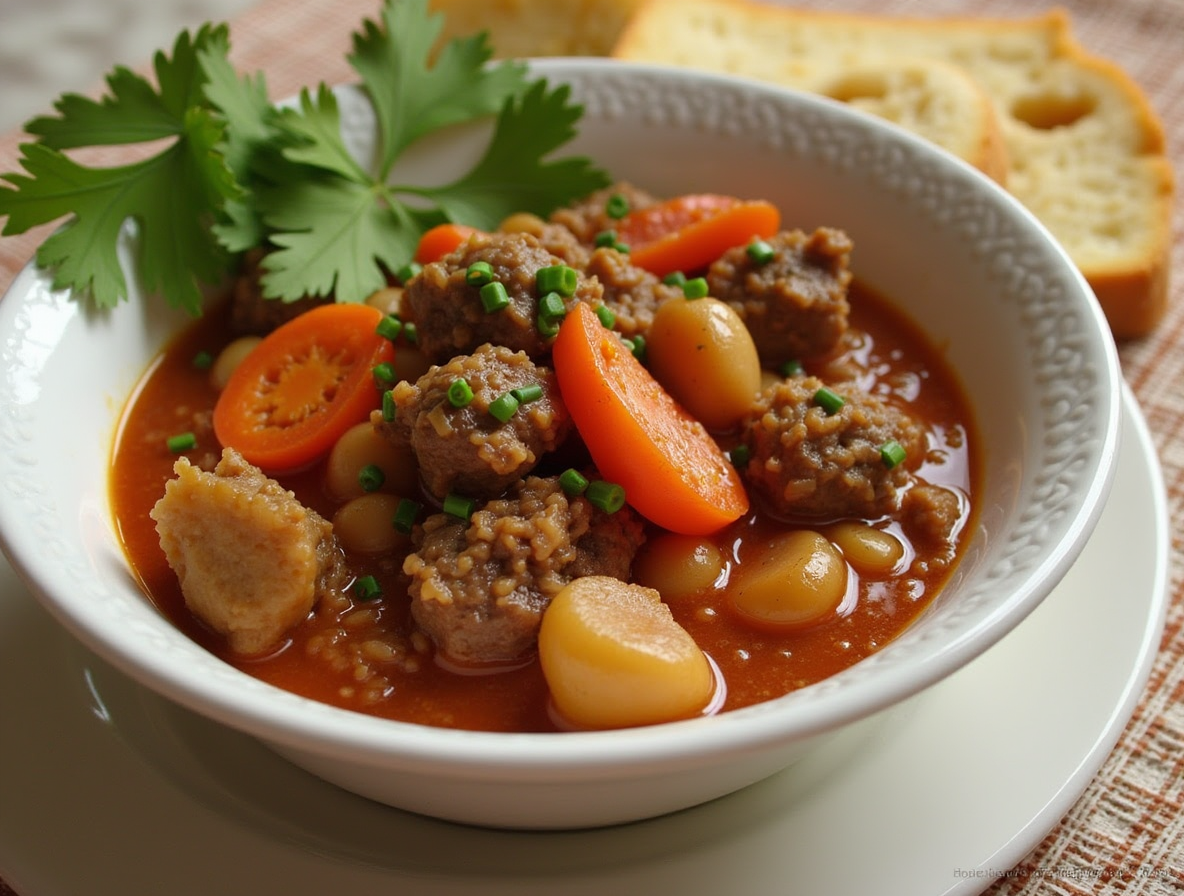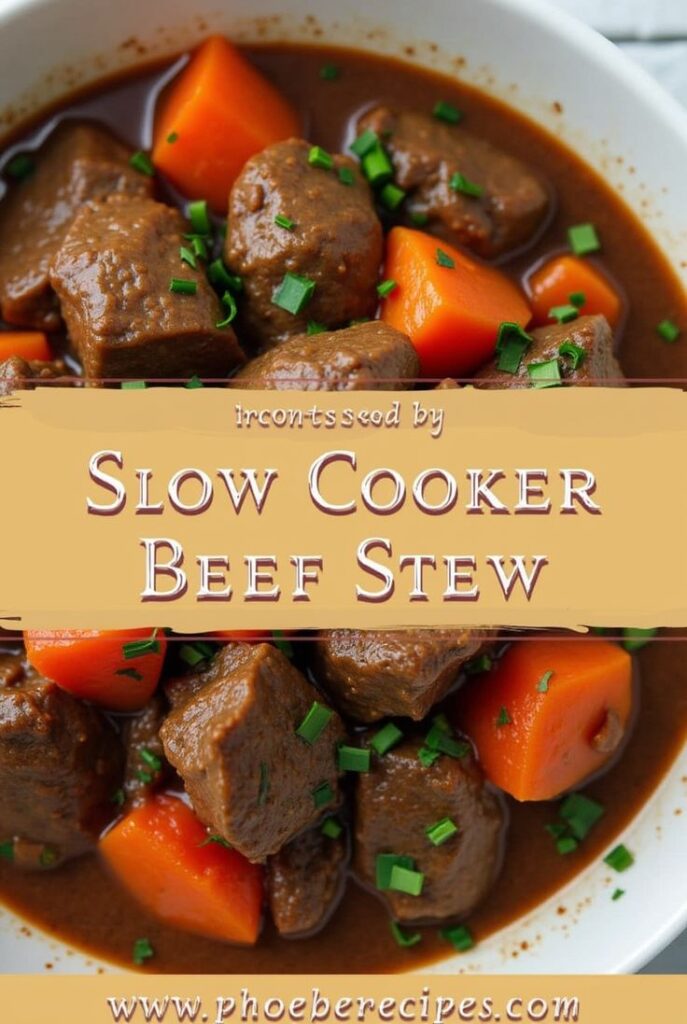How to Make the Perfect Slow Cooker Beef Stew
There’s nothing quite like a hearty slow cooker beef stew on a cold winter night – it’s truly a “hug-in-a-bowl” that warms you from the inside out. I’ve spent years perfecting this traditional recipe, which transforms 2½ pounds of chuck roast into fork-tender bites after just 8 hours of gentle cooking.
After all, the best slow cooker beef stew recipe isn’t just about throwing ingredients together. It’s about patience – allowing those economical cuts of beef to break down their connective tissues while Yukon Gold potatoes maintain their perfect shape throughout the cooking process. Our easy slow cooker beef stew delivers an impressive 507 calories and 49g of protein per serving, making it as nutritious as it is delicious.
What makes our slow cooker beef stew recipe special? Certainly, it’s those secret additions like rich red wine and Worcestershire sauce that enhance the depth of flavor. Additionally, this practical meal can be stored in the refrigerator for up to 3 days or frozen for up to 3 months, making it perfect for busy schedules.
We’ve included all my grandmother’s time-tested techniques that elevate a simple beef stew into something truly memorable. Whether you serve it with cornbread or toasted French bread, this budget-friendly meal delivers rich, complex flavors that only improve with time. Let me show you how to create this classic comfort food just like Grandma used to make!
Choosing the Right Ingredients
The foundation of any remarkable slow cooker beef stew begins with selecting ingredients that will perform well during long, gentle cooking. Making thoughtful choices at this stage dramatically influences your final result.
Best cuts of beef for slow cooking
Choosing the right beef cut is perhaps the most critical decision for your stew. Boneless beef chuck roast stands out as the champion choice for slow cooker beef stew. This economical cut comes from the shoulder area of the cow and contains ideal marbling with connective tissue that breaks down during slow cooking, yielding fork-tender results. Furthermore, chuck delivers rich, beefy flavor that forms the backbone of your stew.
If you’re looking to elevate your beef stew recipe, bone-in short ribs offer exceptional flavor and consistent texture, though at a higher price point. Notably, avoid pre-packaged “stew meat,” as it often contains mixed cuts that cook unevenly.
Potatoes that hold their shape
For potatoes that maintain their integrity through hours of simmering, Yukon Gold and red potatoes are your best allies. Unlike starchy russets that disintegrate and turn mushy, these waxy varieties retain their shape and texture even after extended cooking. I prefer small potatoes measuring 1-2 inches in diameter – cutting larger ones into halves ensures even cooking.
Vegetables that add flavor and texture
A hearty slow cooker beef stew relies on a foundation of aromatic vegetables. Carrots, onions, and celery form the classic trio that creates depth and complexity. Consider cutting these vegetables into substantial chunks rather than small pieces, especially if they’ll cook for the full duration. Otherwise, mushrooms, pearl onions, and baby carrots can be added later in the cooking process to preserve their texture.
Optional ingredients for extra depth
What transforms a good beef stew into an outstanding one? Often, it’s those special additions that provide complexity. Tomato paste offers richness and acidity that balances the savory elements. Meanwhile, Worcestershire sauce adds umami notes that enhance the beef flavor. For additional dimension, deglaze your searing pan with red wine or sherry before adding the liquid to your slow cooker. These subtle additions make the difference between an ordinary stew and one worthy of passing down through generations.
Step-by-Step: How to Make Slow Cooker Beef Stew
Creating the perfect slow cooker beef stew requires attention to detail at each step. Let’s break down the process into manageable steps that anyone can follow.
1. Prep and season the beef
Start by trimming your beef chuck of excess fat, then cut it into 1-inch cubes. Place the meat in a large bowl or plastic bag. Mix together flour, salt, pepper, and garlic powder in a separate bowl. Pour this mixture over the beef and toss until each piece is evenly coated. This flour coating not only seasons the meat but also helps thicken the stew as it cooks.
2. Sear the meat for flavor
Heat olive oil in a large skillet over medium-high heat. Working in batches to avoid overcrowding, brown the beef for about 2-3 minutes per side. This step is crucial as it creates a flavorful crust that seals in juices and adds depth to your stew. Once browned, transfer the meat to your slow cooker.
3. Layer ingredients in the slow cooker
Proper layering makes a significant difference. Place the seared beef at the bottom of your 6-quart slow cooker first. Next, add sturdy vegetables like carrots, potatoes, and celery. Finally, add your onions and garlic. This arrangement ensures everything cooks properly – meat stays close to the heat source while vegetables maintain their texture.
4. Add liquids and seasonings
Pour beef broth into the hot skillet and scrape up any browned bits (deglazing). This captures all the rich flavors from searing. Add this liquid to your slow cooker along with:
- Worcestershire sauce
- Tomato paste
- Bay leaves
- Thyme and rosemary
- Optional red wine
5. Cook low and slow for best results
Cover and cook on low for 7-8 hours or high for 3-4 hours. Cooking on low yields the most tender meat and developed flavors. Avoid lifting the lid during cooking as this releases heat and moisture, potentially adding 15-20 minutes to your cooking time.
6. Add peas and thicken at the end
During the final 15-30 minutes, prepare a cornstarch slurry by mixing 2-3 tablespoons cornstarch with cold water. Stir this into the stew to thicken. Subsequently, add frozen peas – they’ll cook perfectly in the residual heat without becoming mushy. Some chefs also swirl in a tablespoon of cold butter at the very end for a silky finish.
Grandma’s Secret Tips for the Best Stew
What separates an ordinary slow cooker beef stew from one that creates lasting memories? Often, it’s those special techniques passed down through generations. My grandmother’s cooking wisdom transformed simple ingredients into extraordinary meals, and now I’m sharing her best-kept secrets.
Use Worcestershire and tomato paste for umami
The magic of a truly memorable slow cooker beef stew lies in its depth of flavor. Worcestershire sauce, with its fermented anchovy base, adds complex umami notes that enhance the beef’s natural savoriness. Just 1-2 tablespoons will dramatically transform your stew. Similarly, tomato paste provides concentrated richness and subtle acidity. Instead of simply adding it, try this technique: after searing your meat, push it to one side of the pan and cook 1-2 tablespoons of tomato paste in the remaining oil for 30-60 seconds until it darkens slightly. This process, called “blooming,” intensifies its flavor considerably.
Deglaze the pan with wine or broth
Following the meat-searing process, your pan contains caramelized bits (fond) packed with flavor. Consequently, deglazing becomes essential. Pour ¼ cup of red wine or beef broth into the hot pan and scrape vigorously with a wooden spoon. This simple step captures concentrated flavor molecules that would otherwise be lost. For alcohol-free cooking, alternatively use pomegranate juice or additional beef broth with a splash of balsamic vinegar.
Add butter at the end for a silky finish
One of Grandma’s signature moves involved adding 1-2 tablespoons of cold butter right before serving. This technique, known as “mounting with butter,” creates a velvety mouthfeel that elevates the entire dish. The fat molecules disperse throughout the stew, lending a subtle richness that balances the robust flavors. For best results, ensure your stew is no longer boiling when adding butter to prevent it from separating.
Let it rest before serving
Above all, patience remains crucial even after cooking is complete. Allow your slow cooker beef stew to rest with the lid off for 10-15 minutes before serving. During this time, flavors continue melding while the stew reaches the perfect temperature for enjoying. This brief rest period also allows the thickness to stabilize, preventing that too-hot first bite that dulls your taste buds.
Serving, Storing, and Reheating
A perfect slow cooker beef stew deserves to be paired with complementary sides and properly stored to enjoy later. These practical tips will help you complete your meal and preserve leftovers properly.
Best sides to serve with beef stew
Crusty bread stands as the quintessential partner for slow cooker beef stew, perfect for soaking up every last drop of that rich gravy. I prefer serving French bread, cornbread muffins, or garlic bread alongside my stew. For a heartier meal, consider these options:
- Creamy mashed potatoes or polenta
- Roasted vegetables like Brussels sprouts or green beans
- Fresh salads with tangy dressings to balance the stew’s richness
Whenever I want to stretch my slow cooker beef stew further, I pair it with steamed green vegetables or a pear and arugula salad for contrast.
How to store leftovers properly
First, allow your stew to cool completely before refrigerating. This prevents temperature fluctuations in your refrigerator that could affect other foods. Transfer cooled stew to airtight containers, leaving some headspace for expansion.
Properly stored slow cooker beef stew will keep in the refrigerator for 3-4 days. I’ve found that the flavors actually improve the next day as they continue to develop—making this dish ideal for meal prep.
Freezing and reheating tips
For longer storage, freeze your beef stew in practical portions. Leave about ½-inch of space in containers to allow for expansion. Properly frozen stew maintains quality for up to 3 months.
Most importantly, thaw frozen stew overnight in the refrigerator before reheating. I primarily reheat mine in a cast iron pot over low heat on the stovetop. If the stew seems too thick after freezing, simply add a splash of beef broth to restore its consistency.
Remember that potatoes can become soft after freezing, so if you’re planning to freeze your slow cooker beef stew, consider adding freshly cooked potatoes when reheating.
Conclusion
Slow cooker beef stew certainly stands as one of the most comforting and satisfying meals you can prepare for your family. Throughout this article, we’ve explored how choosing chuck roast transforms an economical cut into something truly special after those crucial 7-8 hours of gentle cooking. Additionally, we’ve uncovered the importance of selecting waxy potatoes like Yukon Gold that maintain their integrity rather than dissolving into the broth.
Grandma’s wisdom reminds us that true culinary magic happens in those little details – deglazing the pan to capture concentrated flavors, blooming tomato paste for depth, and finishing with cold butter for silky richness. These techniques elevate a simple beef stew into a memorable meal worthy of passing down through generations.
Most importantly, this hearty dish offers remarkable versatility beyond its incredible flavor. The ability to store leftovers for several days or freeze portions for up to three months makes slow cooker beef stew an excellent option for busy households. Many home cooks even find the flavors improve after a day in the refrigerator as the ingredients continue melding together.
The next time winter winds howl outside your window, remember these time-tested techniques. Your kitchen will fill with irresistible aromas while you create not just a nutritious meal but also a tradition that brings comfort and connection to your table. After all, the best recipes do more than feed our bodies – they warm our souls and create lasting memories around the family dinner table.
FAQs
Q1. What’s the secret to making tender beef in a slow cooker stew? The key is to cook the stew low and slow. Use tough cuts of meat with connective tissue like chuck roast, and cook on low for 7-8 hours. This allows the collagen to break down, resulting in tender, flavorful beef.
Q2. How can I thicken my slow cooker beef stew? To thicken the stew, make a cornstarch slurry by mixing 2-3 tablespoons of cornstarch with cold water. Stir this into the stew during the last 30 minutes of cooking. You can also coat the beef in flour before browning it, which will help thicken the stew as it cooks.
Q3. What vegetables work best in a slow cooker beef stew? Sturdy root vegetables like carrots, potatoes, and parsnips hold up well during long cooking. Add them at the beginning. For a pop of color and freshness, add frozen peas in the last 30 minutes of cooking. Onions and celery also add great flavor to the base.
Q4. How can I enhance the flavor of my slow cooker beef stew? Brown the meat before adding it to the slow cooker to develop a deeper flavor. Use beef broth as the cooking liquid and add flavor boosters like Worcestershire sauce, tomato paste, and red wine. Don’t forget herbs like thyme and bay leaves. Season well with salt and pepper at the end.
Q5. Can I make beef stew ahead of time in a slow cooker? Yes, beef stew is perfect for making ahead. Cook it fully, then cool and refrigerate for up to 3-4 days. The flavors often improve after a day or two. You can also freeze portions for up to 3 months. Reheat gently on the stovetop or in the microwave, adding a splash of broth if needed to thin the sauce.


